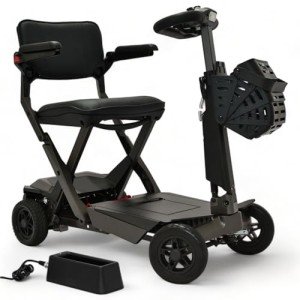A Comprehensive Guide to Buying a Mobility Scooter
Mobility scooters have actually become an essential tool for numerous people looking to boost their self-reliance and mobility. With a large range of designs and features available, picking the right mobility scooter can be daunting. This article provides an informative guide to assist consumers browse their choices, evaluate their needs, and make a notified purchase.
Understanding Mobility Scooters
Mobility scooters are electric vehicles created for people who experience mobility difficulties. They are especially advantageous for senior citizens, those with specials needs, or individuals recovering from injuries. Going Here can differ widely in terms of style, features, and rates.
Types of Mobility Scooters
Before embarking on a purchase, it's essential to comprehend the various kinds of mobility scooters offered:
Three-Wheel Scooters:
- Generally more maneuverable in tight spaces
- Lightweight and portable
- Ideal for indoor use
Four-Wheel Scooters:
- Offer greater stability and balance
- Suitable for outdoor use over different terrains
- Normally have a longer battery life
Foldable/Portable Scooters:
- Designed to be quickly transported and stored
- Can frequently suit the trunk of a vehicle
- Ideal for those who take a trip regularly
Sturdy Scooters:
- Built to accommodate bigger individuals
- Often featured more robust functions for outside use
- Generally equipped with larger batteries for extended variety
Elements to Consider When Buying a Mobility Scooter
1. Weight Capacity
Select a mobility scooter that can support the user's weight. Many scooters have a weight limitation varying from 250 to 500 pounds. It is essential to ensure that the scooter can accommodate the user easily.
2. Range and Battery Life
The variety is how far the mobility scooter can take a trip on a single charge. Common varieties differ between 10 to 30 miles. Think about the user's everyday activities and pick a scooter with an appropriate variety.
3. Scooter Dimensions
Consider the size of the scooter, including its weight and dimensions. A more compact scooter may be ideal for narrow corridors and tight areas, while bigger designs offer extra stability and comfort.
4. Surface Capability
Evaluate where the scooter will mostly be used. If the user plans to take a trip primarily on pavement, a lightweight model might suffice. Nevertheless, if the user needs to pass through gravel or irregular surface areas, consider a four-wheel scooter constructed for off-road use.
Leading Features to Look For
Comfort
- Adjustable Seats: Look for scooters with cushioned and height-adjustable seats to make sure comfort throughout travel.
- Armrests: These boost security and assistance while browsing.
Safety and Visibility
- Headlights and Taillights: Essential for nighttime usage.
- Turn Signals and Reflectors: Improve visibility and safety while on the road.
User-Friendly Controls
- Joystick or Drive Controls: These ought to be user-friendly and easy to control.
- Easy-to-Read Displays: A control panel that shows battery life, speed, and range can enhance the user experience.
Extra Features
- Storage Compartments: These provide included benefit for bring individual products while on the go.
- Weather condition Protection: Consider designs with rain covers or windscreens if utilized in variable weather condition conditions.
Cost Considerations
When budgeting for a mobility scooter, costs can vary anywhere from ₤ 500 to over ₤ 5,000 depending upon the design, features, and brand name. Additional expenses might consist of:
- Extended Warranty: Protects versus flaws and can save cash in the long run.
- Devices: Optional features, such as updated seats, lights, or storage options.
| Feature | Expense Range |
|---|---|
| Fundamental Models | ₤ 500 - ₤ 1,500 |
| Mid-Range Models | ₤ 1,500 - ₤ 3,000 |
| High-End Models | ₤ 3,000 - ₤ 5,000 |
Financing Options
Many merchants provide funding plans, and some regional government initiatives may provide grants or help for those in requirement. Investigate possible monetary assistance with neighborhood resources or mobility service companies.
FAQs about Buying a Mobility Scooter
What is the difference between a mobility scooter and a wheelchair?
Mobility scooters are motorized and enable users to navigate individually, while wheelchairs might require physical assistance or manual operation.
How do I preserve a mobility scooter?
Routine maintenance involves checking battery life, cleaning up the scooter, and checking tires and brakes. Always describe the user handbook for particular standards.
Can mobility scooters be utilized inside?
Yes, numerous designs are created for both indoor and outdoor use. However, three-wheel scooters tend to be better fit for indoor navigation due to their tighter turning radius.
Are mobility scooters covered by insurance coverage?
Some insurance plans cover a portion of the costs for mobility scooters if they are considered clinically essential. Contact your service provider for particular information.
How quickly can a mobility scooter go?
Many mobility scooters have a maximum speed varying from 4 to 8 miles per hour. However, the appropriate pace may vary depending upon local guidelines.
Getting a mobility scooter can considerably boost one's self-reliance and lifestyle. By understanding the types, features, and costs connected with mobility scooters, prospective buyers can make well-informed choices that suit their needs and choices. Customization and thorough research are key to ensuring satisfaction with this essential investment.

